Financial Feasibility Case Study: Launching a New Machine at CMC
VerifiedAdded on 2023/06/11
|7
|1553
|324
Case Study
AI Summary
This case study examines the financial feasibility of Coffee Manufacturing Company's (CMC) plan to launch a new coffee machine. It details the estimation of incremental cash flows, considering factors like opportunity costs, depreciation, and potential competitive responses. The analysis uses Net Present Value (NPV) to determine project viability, concluding that the project is financially feasible due to a positive NPV. The study also highlights the importance of considering competitor reactions, uncertainty analysis, and broader market impacts for a comprehensive evaluation. Desklib provides a platform for students to access this and other solved assignments.
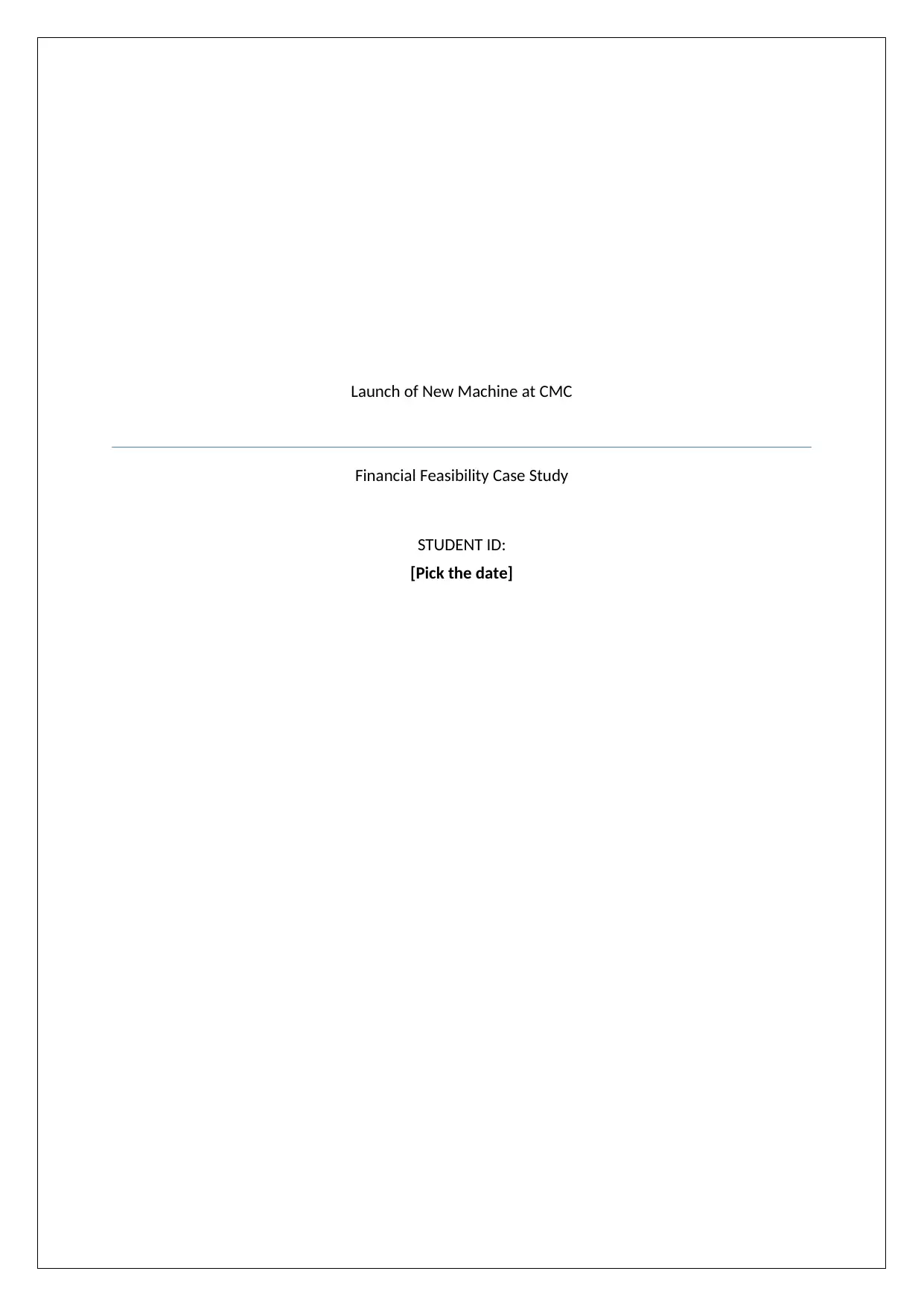
Launch of New Machine at CMC
Financial Feasibility Case Study
STUDENT ID:
[Pick the date]
Financial Feasibility Case Study
STUDENT ID:
[Pick the date]
Paraphrase This Document
Need a fresh take? Get an instant paraphrase of this document with our AI Paraphraser
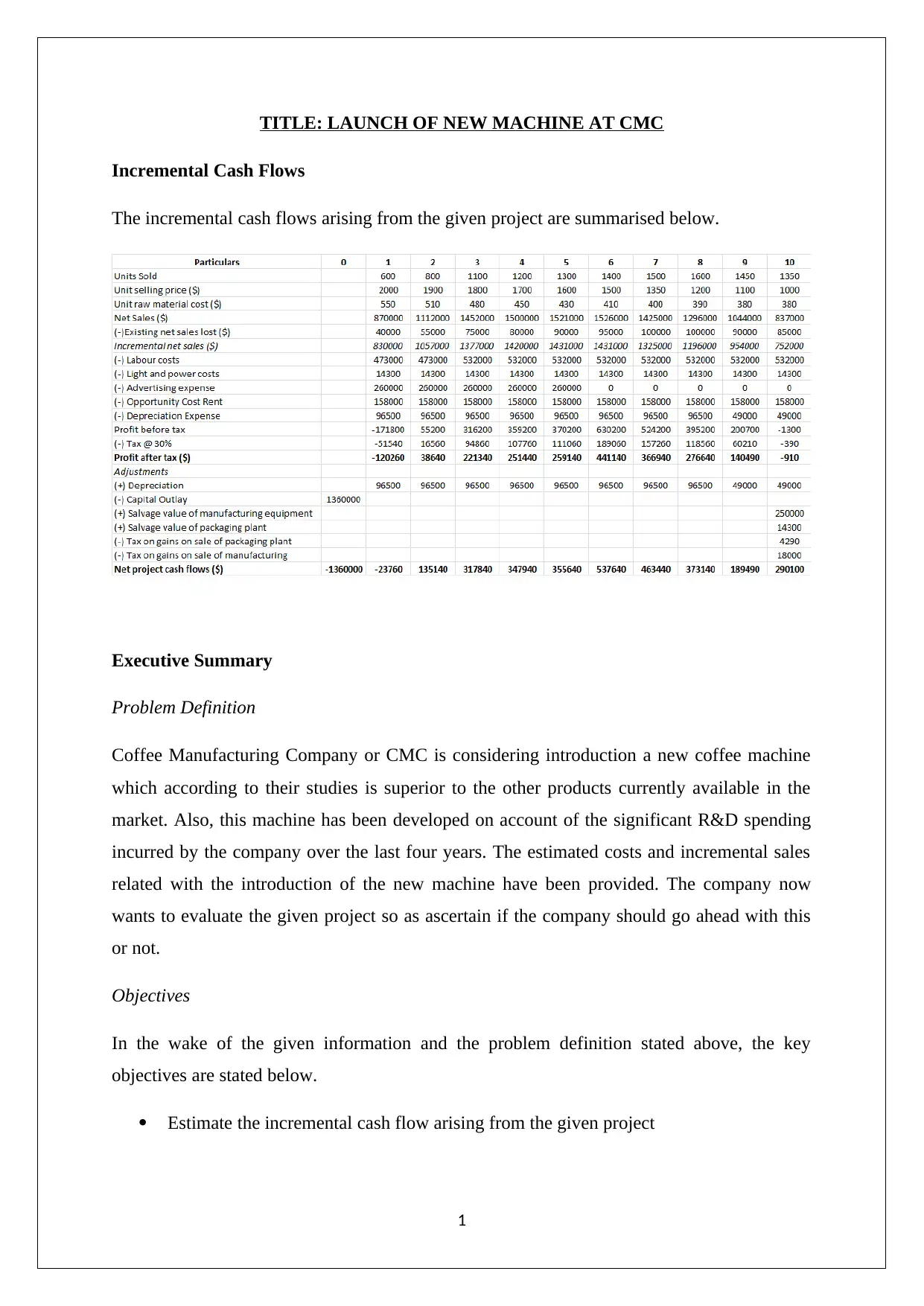
TITLE: LAUNCH OF NEW MACHINE AT CMC
Incremental Cash Flows
The incremental cash flows arising from the given project are summarised below.
Executive Summary
Problem Definition
Coffee Manufacturing Company or CMC is considering introduction a new coffee machine
which according to their studies is superior to the other products currently available in the
market. Also, this machine has been developed on account of the significant R&D spending
incurred by the company over the last four years. The estimated costs and incremental sales
related with the introduction of the new machine have been provided. The company now
wants to evaluate the given project so as ascertain if the company should go ahead with this
or not.
Objectives
In the wake of the given information and the problem definition stated above, the key
objectives are stated below.
Estimate the incremental cash flow arising from the given project
1
Incremental Cash Flows
The incremental cash flows arising from the given project are summarised below.
Executive Summary
Problem Definition
Coffee Manufacturing Company or CMC is considering introduction a new coffee machine
which according to their studies is superior to the other products currently available in the
market. Also, this machine has been developed on account of the significant R&D spending
incurred by the company over the last four years. The estimated costs and incremental sales
related with the introduction of the new machine have been provided. The company now
wants to evaluate the given project so as ascertain if the company should go ahead with this
or not.
Objectives
In the wake of the given information and the problem definition stated above, the key
objectives are stated below.
Estimate the incremental cash flow arising from the given project
1
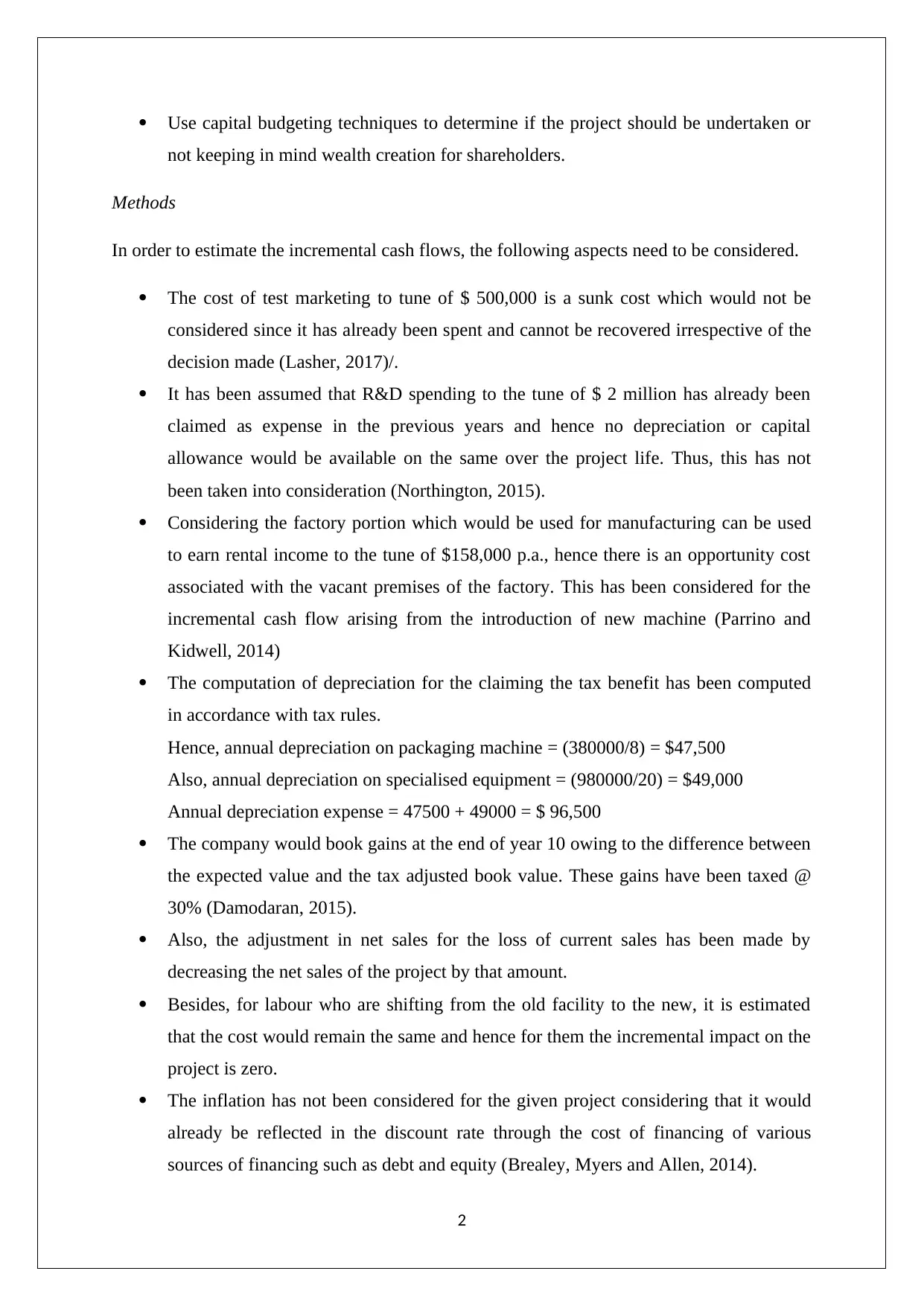
Use capital budgeting techniques to determine if the project should be undertaken or
not keeping in mind wealth creation for shareholders.
Methods
In order to estimate the incremental cash flows, the following aspects need to be considered.
The cost of test marketing to tune of $ 500,000 is a sunk cost which would not be
considered since it has already been spent and cannot be recovered irrespective of the
decision made (Lasher, 2017)/.
It has been assumed that R&D spending to the tune of $ 2 million has already been
claimed as expense in the previous years and hence no depreciation or capital
allowance would be available on the same over the project life. Thus, this has not
been taken into consideration (Northington, 2015).
Considering the factory portion which would be used for manufacturing can be used
to earn rental income to the tune of $158,000 p.a., hence there is an opportunity cost
associated with the vacant premises of the factory. This has been considered for the
incremental cash flow arising from the introduction of new machine (Parrino and
Kidwell, 2014)
The computation of depreciation for the claiming the tax benefit has been computed
in accordance with tax rules.
Hence, annual depreciation on packaging machine = (380000/8) = $47,500
Also, annual depreciation on specialised equipment = (980000/20) = $49,000
Annual depreciation expense = 47500 + 49000 = $ 96,500
The company would book gains at the end of year 10 owing to the difference between
the expected value and the tax adjusted book value. These gains have been taxed @
30% (Damodaran, 2015).
Also, the adjustment in net sales for the loss of current sales has been made by
decreasing the net sales of the project by that amount.
Besides, for labour who are shifting from the old facility to the new, it is estimated
that the cost would remain the same and hence for them the incremental impact on the
project is zero.
The inflation has not been considered for the given project considering that it would
already be reflected in the discount rate through the cost of financing of various
sources of financing such as debt and equity (Brealey, Myers and Allen, 2014).
2
not keeping in mind wealth creation for shareholders.
Methods
In order to estimate the incremental cash flows, the following aspects need to be considered.
The cost of test marketing to tune of $ 500,000 is a sunk cost which would not be
considered since it has already been spent and cannot be recovered irrespective of the
decision made (Lasher, 2017)/.
It has been assumed that R&D spending to the tune of $ 2 million has already been
claimed as expense in the previous years and hence no depreciation or capital
allowance would be available on the same over the project life. Thus, this has not
been taken into consideration (Northington, 2015).
Considering the factory portion which would be used for manufacturing can be used
to earn rental income to the tune of $158,000 p.a., hence there is an opportunity cost
associated with the vacant premises of the factory. This has been considered for the
incremental cash flow arising from the introduction of new machine (Parrino and
Kidwell, 2014)
The computation of depreciation for the claiming the tax benefit has been computed
in accordance with tax rules.
Hence, annual depreciation on packaging machine = (380000/8) = $47,500
Also, annual depreciation on specialised equipment = (980000/20) = $49,000
Annual depreciation expense = 47500 + 49000 = $ 96,500
The company would book gains at the end of year 10 owing to the difference between
the expected value and the tax adjusted book value. These gains have been taxed @
30% (Damodaran, 2015).
Also, the adjustment in net sales for the loss of current sales has been made by
decreasing the net sales of the project by that amount.
Besides, for labour who are shifting from the old facility to the new, it is estimated
that the cost would remain the same and hence for them the incremental impact on the
project is zero.
The inflation has not been considered for the given project considering that it would
already be reflected in the discount rate through the cost of financing of various
sources of financing such as debt and equity (Brealey, Myers and Allen, 2014).
2
⊘ This is a preview!⊘
Do you want full access?
Subscribe today to unlock all pages.

Trusted by 1+ million students worldwide
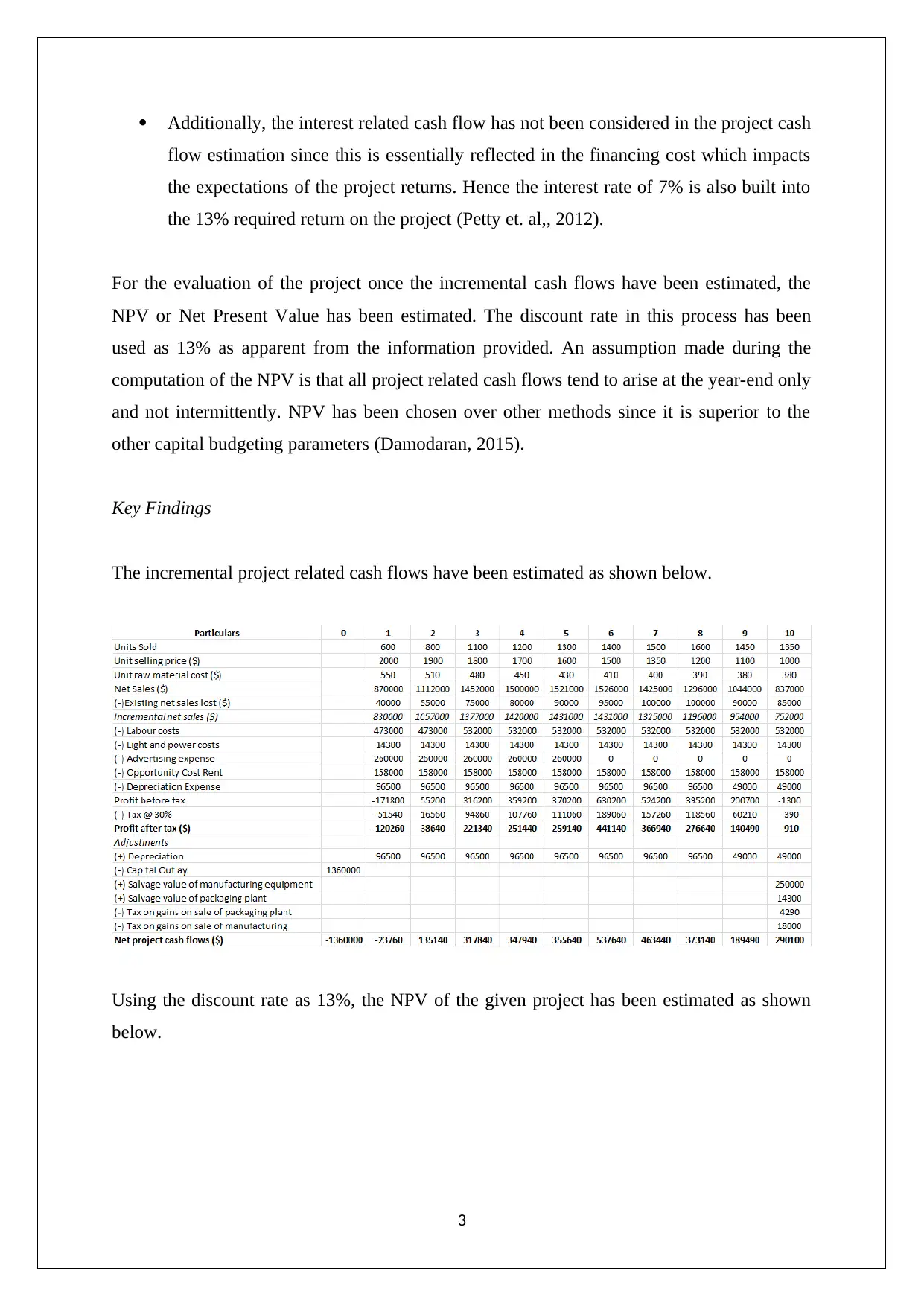
Additionally, the interest related cash flow has not been considered in the project cash
flow estimation since this is essentially reflected in the financing cost which impacts
the expectations of the project returns. Hence the interest rate of 7% is also built into
the 13% required return on the project (Petty et. al,, 2012).
For the evaluation of the project once the incremental cash flows have been estimated, the
NPV or Net Present Value has been estimated. The discount rate in this process has been
used as 13% as apparent from the information provided. An assumption made during the
computation of the NPV is that all project related cash flows tend to arise at the year-end only
and not intermittently. NPV has been chosen over other methods since it is superior to the
other capital budgeting parameters (Damodaran, 2015).
Key Findings
The incremental project related cash flows have been estimated as shown below.
Using the discount rate as 13%, the NPV of the given project has been estimated as shown
below.
3
flow estimation since this is essentially reflected in the financing cost which impacts
the expectations of the project returns. Hence the interest rate of 7% is also built into
the 13% required return on the project (Petty et. al,, 2012).
For the evaluation of the project once the incremental cash flows have been estimated, the
NPV or Net Present Value has been estimated. The discount rate in this process has been
used as 13% as apparent from the information provided. An assumption made during the
computation of the NPV is that all project related cash flows tend to arise at the year-end only
and not intermittently. NPV has been chosen over other methods since it is superior to the
other capital budgeting parameters (Damodaran, 2015).
Key Findings
The incremental project related cash flows have been estimated as shown below.
Using the discount rate as 13%, the NPV of the given project has been estimated as shown
below.
3
Paraphrase This Document
Need a fresh take? Get an instant paraphrase of this document with our AI Paraphraser
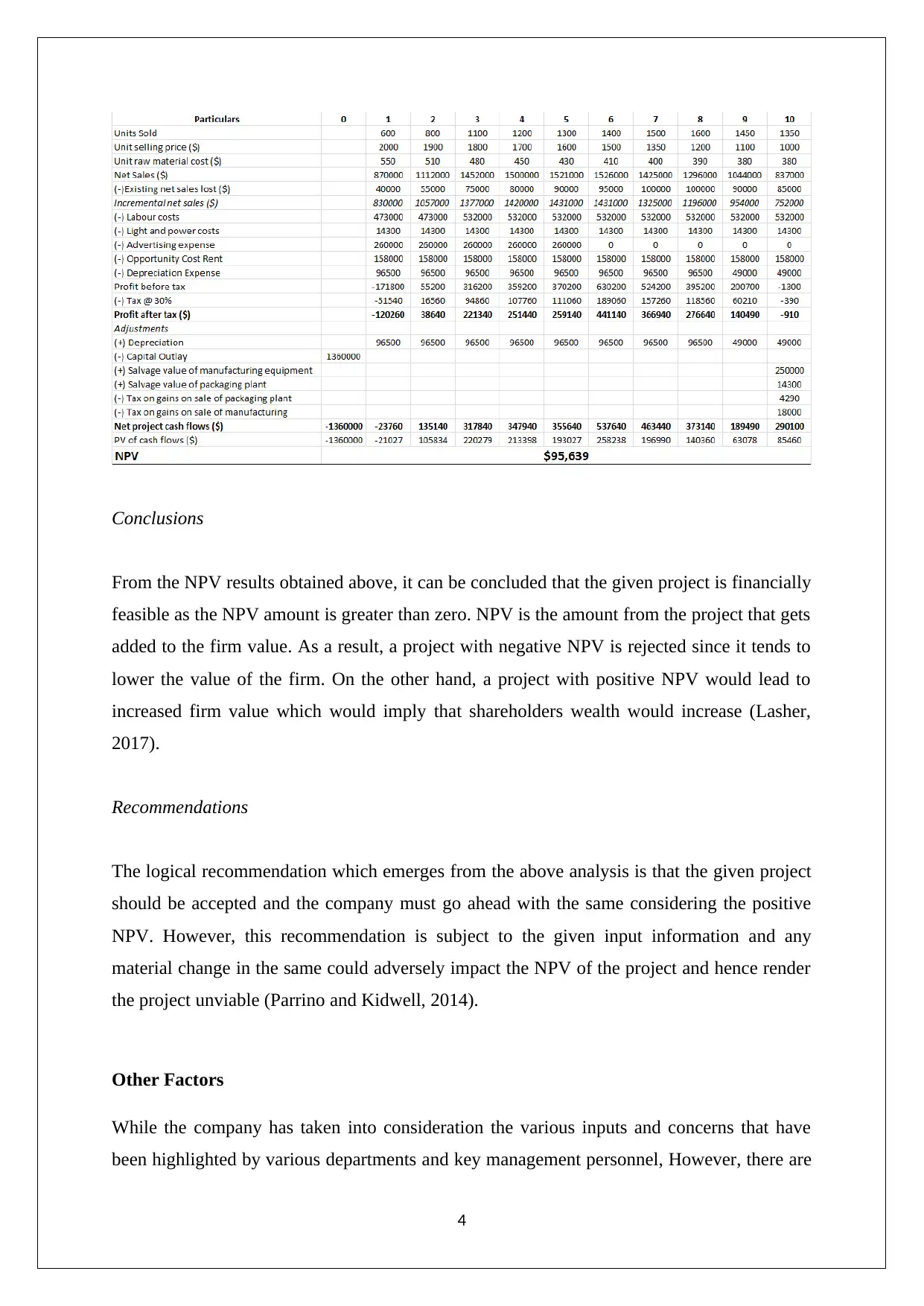
Conclusions
From the NPV results obtained above, it can be concluded that the given project is financially
feasible as the NPV amount is greater than zero. NPV is the amount from the project that gets
added to the firm value. As a result, a project with negative NPV is rejected since it tends to
lower the value of the firm. On the other hand, a project with positive NPV would lead to
increased firm value which would imply that shareholders wealth would increase (Lasher,
2017).
Recommendations
The logical recommendation which emerges from the above analysis is that the given project
should be accepted and the company must go ahead with the same considering the positive
NPV. However, this recommendation is subject to the given input information and any
material change in the same could adversely impact the NPV of the project and hence render
the project unviable (Parrino and Kidwell, 2014).
Other Factors
While the company has taken into consideration the various inputs and concerns that have
been highlighted by various departments and key management personnel, However, there are
4
From the NPV results obtained above, it can be concluded that the given project is financially
feasible as the NPV amount is greater than zero. NPV is the amount from the project that gets
added to the firm value. As a result, a project with negative NPV is rejected since it tends to
lower the value of the firm. On the other hand, a project with positive NPV would lead to
increased firm value which would imply that shareholders wealth would increase (Lasher,
2017).
Recommendations
The logical recommendation which emerges from the above analysis is that the given project
should be accepted and the company must go ahead with the same considering the positive
NPV. However, this recommendation is subject to the given input information and any
material change in the same could adversely impact the NPV of the project and hence render
the project unviable (Parrino and Kidwell, 2014).
Other Factors
While the company has taken into consideration the various inputs and concerns that have
been highlighted by various departments and key management personnel, However, there are
4
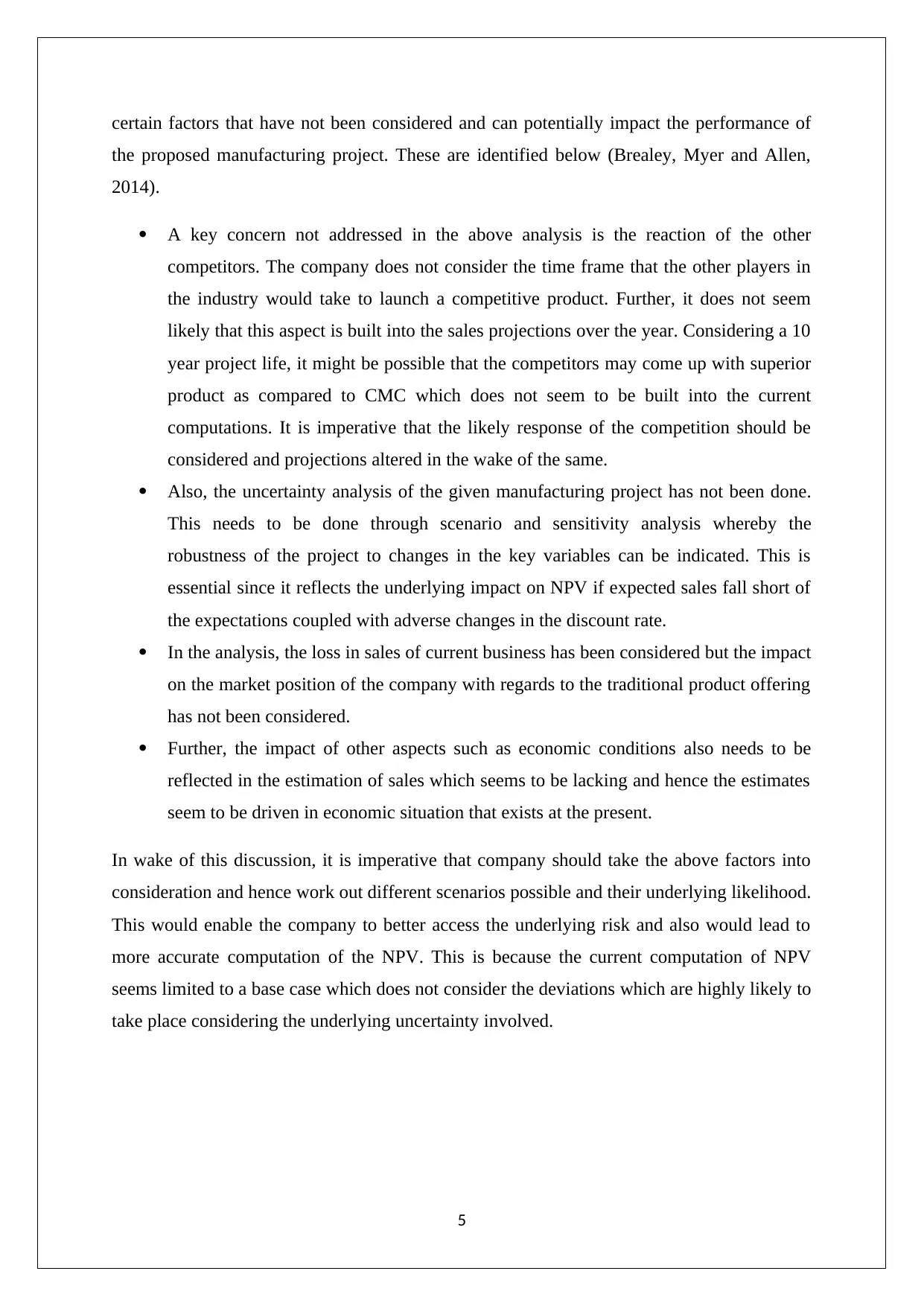
certain factors that have not been considered and can potentially impact the performance of
the proposed manufacturing project. These are identified below (Brealey, Myer and Allen,
2014).
A key concern not addressed in the above analysis is the reaction of the other
competitors. The company does not consider the time frame that the other players in
the industry would take to launch a competitive product. Further, it does not seem
likely that this aspect is built into the sales projections over the year. Considering a 10
year project life, it might be possible that the competitors may come up with superior
product as compared to CMC which does not seem to be built into the current
computations. It is imperative that the likely response of the competition should be
considered and projections altered in the wake of the same.
Also, the uncertainty analysis of the given manufacturing project has not been done.
This needs to be done through scenario and sensitivity analysis whereby the
robustness of the project to changes in the key variables can be indicated. This is
essential since it reflects the underlying impact on NPV if expected sales fall short of
the expectations coupled with adverse changes in the discount rate.
In the analysis, the loss in sales of current business has been considered but the impact
on the market position of the company with regards to the traditional product offering
has not been considered.
Further, the impact of other aspects such as economic conditions also needs to be
reflected in the estimation of sales which seems to be lacking and hence the estimates
seem to be driven in economic situation that exists at the present.
In wake of this discussion, it is imperative that company should take the above factors into
consideration and hence work out different scenarios possible and their underlying likelihood.
This would enable the company to better access the underlying risk and also would lead to
more accurate computation of the NPV. This is because the current computation of NPV
seems limited to a base case which does not consider the deviations which are highly likely to
take place considering the underlying uncertainty involved.
5
the proposed manufacturing project. These are identified below (Brealey, Myer and Allen,
2014).
A key concern not addressed in the above analysis is the reaction of the other
competitors. The company does not consider the time frame that the other players in
the industry would take to launch a competitive product. Further, it does not seem
likely that this aspect is built into the sales projections over the year. Considering a 10
year project life, it might be possible that the competitors may come up with superior
product as compared to CMC which does not seem to be built into the current
computations. It is imperative that the likely response of the competition should be
considered and projections altered in the wake of the same.
Also, the uncertainty analysis of the given manufacturing project has not been done.
This needs to be done through scenario and sensitivity analysis whereby the
robustness of the project to changes in the key variables can be indicated. This is
essential since it reflects the underlying impact on NPV if expected sales fall short of
the expectations coupled with adverse changes in the discount rate.
In the analysis, the loss in sales of current business has been considered but the impact
on the market position of the company with regards to the traditional product offering
has not been considered.
Further, the impact of other aspects such as economic conditions also needs to be
reflected in the estimation of sales which seems to be lacking and hence the estimates
seem to be driven in economic situation that exists at the present.
In wake of this discussion, it is imperative that company should take the above factors into
consideration and hence work out different scenarios possible and their underlying likelihood.
This would enable the company to better access the underlying risk and also would lead to
more accurate computation of the NPV. This is because the current computation of NPV
seems limited to a base case which does not consider the deviations which are highly likely to
take place considering the underlying uncertainty involved.
5
⊘ This is a preview!⊘
Do you want full access?
Subscribe today to unlock all pages.

Trusted by 1+ million students worldwide
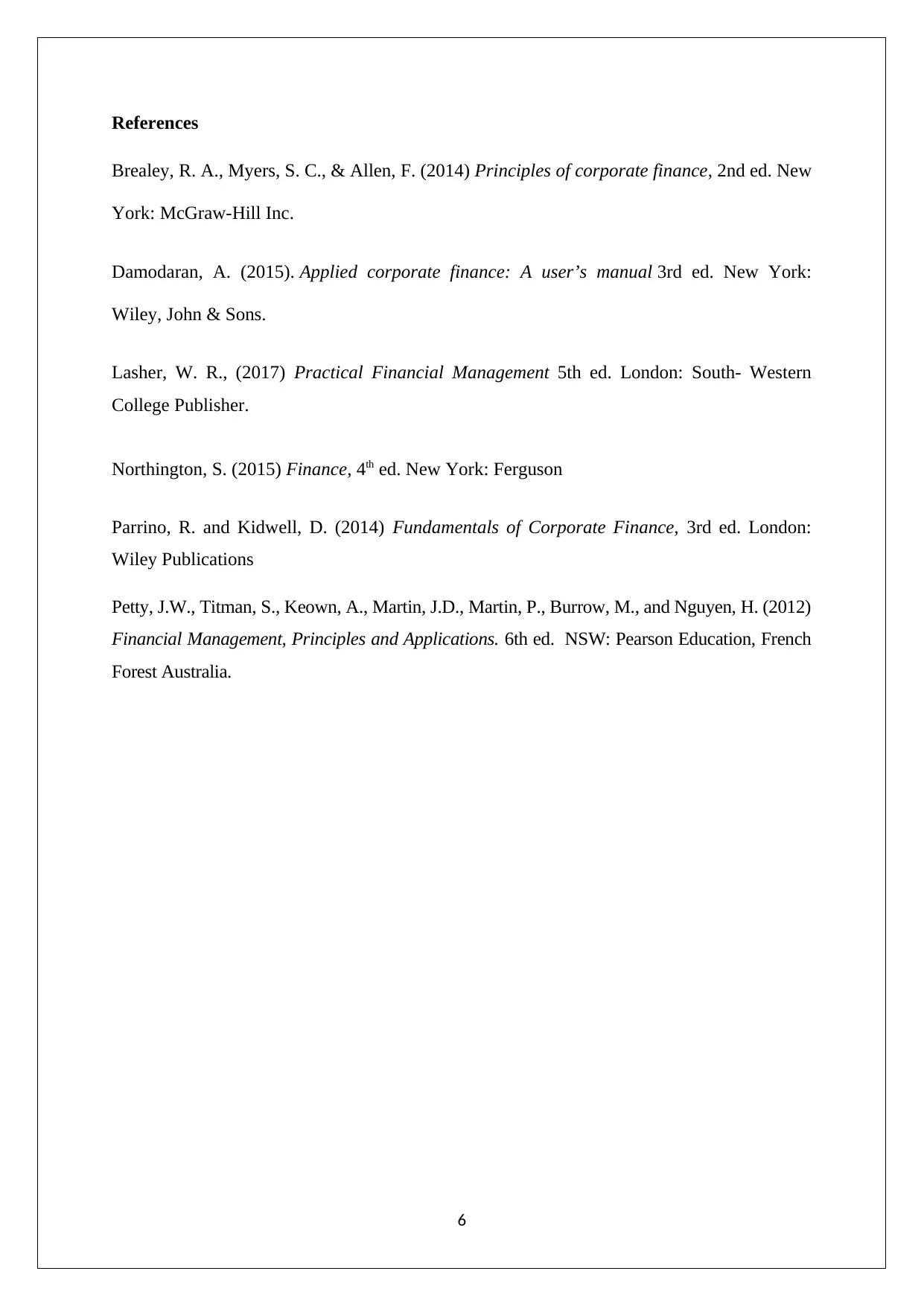
References
Brealey, R. A., Myers, S. C., & Allen, F. (2014) Principles of corporate finance, 2nd ed. New
York: McGraw-Hill Inc.
Damodaran, A. (2015). Applied corporate finance: A user’s manual 3rd ed. New York:
Wiley, John & Sons.
Lasher, W. R., (2017) Practical Financial Management 5th ed. London: South- Western
College Publisher.
Northington, S. (2015) Finance, 4th ed. New York: Ferguson
Parrino, R. and Kidwell, D. (2014) Fundamentals of Corporate Finance, 3rd ed. London:
Wiley Publications
Petty, J.W., Titman, S., Keown, A., Martin, J.D., Martin, P., Burrow, M., and Nguyen, H. (2012)
Financial Management, Principles and Applications. 6th ed. NSW: Pearson Education, French
Forest Australia.
6
Brealey, R. A., Myers, S. C., & Allen, F. (2014) Principles of corporate finance, 2nd ed. New
York: McGraw-Hill Inc.
Damodaran, A. (2015). Applied corporate finance: A user’s manual 3rd ed. New York:
Wiley, John & Sons.
Lasher, W. R., (2017) Practical Financial Management 5th ed. London: South- Western
College Publisher.
Northington, S. (2015) Finance, 4th ed. New York: Ferguson
Parrino, R. and Kidwell, D. (2014) Fundamentals of Corporate Finance, 3rd ed. London:
Wiley Publications
Petty, J.W., Titman, S., Keown, A., Martin, J.D., Martin, P., Burrow, M., and Nguyen, H. (2012)
Financial Management, Principles and Applications. 6th ed. NSW: Pearson Education, French
Forest Australia.
6
1 out of 7
Related Documents
Your All-in-One AI-Powered Toolkit for Academic Success.
+13062052269
info@desklib.com
Available 24*7 on WhatsApp / Email
![[object Object]](/_next/static/media/star-bottom.7253800d.svg)
Unlock your academic potential
Copyright © 2020–2025 A2Z Services. All Rights Reserved. Developed and managed by ZUCOL.





